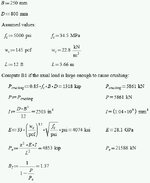structural87
Structural
hello
In section 10.10.2.1 of aci 318-11, it is stated that the ratio of second order to first order moments should not exceed 1.4.
I have a special reinforced concrete shear wall system where i am hinging the columns at their top and bottom so they can take only axial forces and relying solely on the walls for seismic resistance.
In this case, should this limitation of 1.4 still be respected since I don't have end moments at the columns top and bottom except the minimal eccentricity ?
I am using the software Etabs and this latter calculates the delta-ns to cater for small P-delta and provides an error message once the delta-ns > 1.4 while still showing that the percentage is within the limits even by magnifying the minimal moments.
Thx in advance for your input
In section 10.10.2.1 of aci 318-11, it is stated that the ratio of second order to first order moments should not exceed 1.4.
I have a special reinforced concrete shear wall system where i am hinging the columns at their top and bottom so they can take only axial forces and relying solely on the walls for seismic resistance.
In this case, should this limitation of 1.4 still be respected since I don't have end moments at the columns top and bottom except the minimal eccentricity ?
I am using the software Etabs and this latter calculates the delta-ns to cater for small P-delta and provides an error message once the delta-ns > 1.4 while still showing that the percentage is within the limits even by magnifying the minimal moments.
Thx in advance for your input

